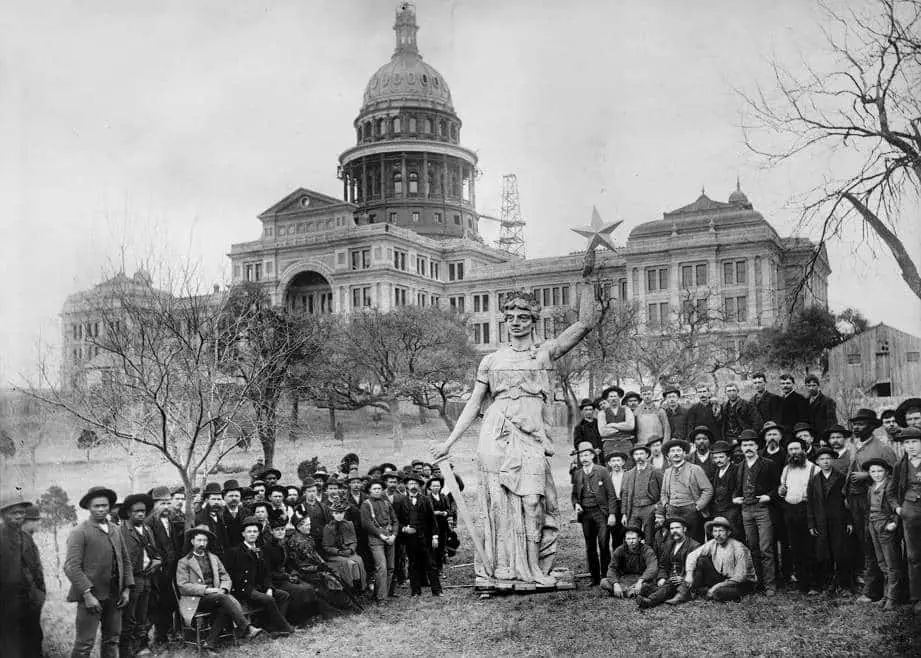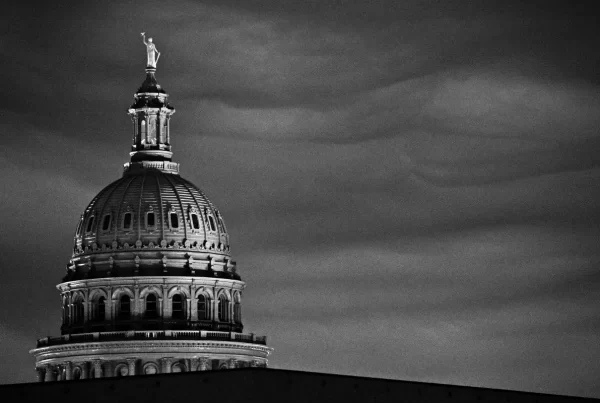The principle of checks and balances is central to democratic governance, ensuring that no single branch of government can dominate the others. It works by distributing power across multiple institutions that can limit each other’s authority. In Texas, the system is built on a separation of powers among three branches: the legislative, executive, and judicial branches. These branches are intentionally designed to check and balance one another, ensuring that no one branch dominates the state’s government.
Texas also has a plural executive system at the state and county levels, which further disperses executive authority across multiple elected officials. Additionally, Texas often delegates powers to independent agencies, giving them significant autonomy and helping to decentralize decision-making authority.
Texas’s system mirrors the checks and balances found at the federal level, where similar principles govern the relationship between the president, Congress, and the courts. However, Texas often goes further, dispersing power even more broadly.
Separation of Powers Among Branches
The Texas Constitution divides the state government into three coequal branches—legislative, executive, and judicial. Each is intended to serve as a check on the others and prevent the concentration of power, while still allowing for cooperation in the exercise of governing authority.
The Plural Executive System in Texas
Unlike the federal government, where executive power is concentrated in the president, Texas disperses executive authority across several independently elected officials. This structure, known as the plural executive system, limits the governor’s power and reflects Texas’s deep-rooted skepticism of centralized authority.
The plural executive includes the governor, lieutenant governor, attorney general, comptroller of public accounts, commissioner of the General Land Office, agriculture commissioner, and the three-member Railroad Commission. Each officeholder is elected separately and wields distinct responsibilities, making coordination more challenging but also reducing the potential for unilateral control.
The governor retains important powers—such as vetoing legislation, calling special sessions, and overseeing state agencies—but these are checked by both the legislature and the decentralized executive structure. For instance, the legislature may override a gubernatorial veto with a two-thirds vote in both chambers. Furthermore, many executive agencies function semi-independently through governing boards and commissions.
Take the Texas Health and Human Services Commission (HHSC), for example. While it administers key health and welfare programs, its major decisions are shaped by an appointed board, limiting the governor’s direct influence and reinforcing the broader dispersal of executive power.
The Lieutenant Governor’s Unique Role
Among Texas’s statewide officials, the lieutenant governor stands out as perhaps the most powerful. Elected separately from the governor, the lieutenant governor presides over the Texas Senate and controls the flow of legislation, including committee assignments and budget deliberations.
This influential role is unlike the largely ceremonial position of the U.S. vice president, who casts tie-breaking votes in the Senate but exercises little day-to-day legislative authority. In Texas, the lieutenant governor often plays a central role in shaping policy and budgetary decisions—functioning as both a legislative leader and a key player in the executive branch.
Other Statewide Elected Officials
Other members of the plural executive wield significant power within their domains. The attorney general represents the state in legal matters and issues binding opinions on the interpretation of law. The comptroller manages tax collection and certifies the state budget. The agriculture commissioner regulates farming and ranching practices, while the land commissioner oversees state-owned lands and mineral rights.
These officials are not subordinate to the governor, and their independent electoral mandates allow them to pursue policies that may differ sharply from those of the governor or legislature. This decentralized structure fosters internal checks within the executive branch itself.
Advertisement
The Legislative Branch
The Texas Legislature is a bicameral body composed of the House of Representatives and the Senate. It enacts laws, appropriates funds, and oversees state agencies, making it a central player in the state’s system of checks and balances.
Texas’s bicameral structure—composed of the House of Representatives and the Senate—further disperses legislative power. Bills must pass through both chambers, each with its own leadership, committees, and procedural rules.
This design slows the pace of lawmaking and encourages deliberation, requiring lawmakers to negotiate, build coalitions, and reconcile differences before legislation can be enacted. The requirement for consensus across two bodies adds another layer of restraint and reflects the broader Texan commitment to limiting the concentration of political power.
In addition to overriding gubernatorial vetoes, the Legislature has the power to impeach and remove executive and judicial officials. These include the governor, lieutenant governor, judges, university board members, and the heads of executive agencies. This authority provides a powerful check on misconduct or abuse of office.
The Judicial Branch
Texas’s judiciary serves as the guardian of constitutional interpretation. It has the authority to strike down laws or executive actions that violate the state constitution, reinforcing the system of checks and balances.
The state maintains two courts of last resort: the Texas Supreme Court for civil matters and the Texas Court of Criminal Appeals for criminal cases. Judges are elected in partisan elections, ensuring popular accountability while maintaining independence from the other branches.
This judicial independence mirrors the federal system, where courts exercise the power of judicial review. Though the landmark case Marbury v. Madison (1803) does not apply directly, Texas courts routinely review laws for constitutionality, acting as a brake on legislative or executive overreach.
County-Level Decentralization
Texas counties echo the state’s plural executive model. Key offices—such as county judge, sheriff, county clerk, and treasurer—are all elected independently. The county judge presides over the commissioners’ court, but does not command the other executive officers.
This decentralized arrangement limits the concentration of authority at the local level, allowing each official to operate with a degree of autonomy. For example, a sheriff answers to voters and cannot be fired by the county’s governing board (the commissioners court), though they control the budget and policies of his department.
Delegation to Independent Agencies
Texas also curtails executive power by delegating important functions to independent agencies governed by boards or commissions. These bodies, though created by the Legislature, often operate with substantial autonomy from both the governor and lawmakers.
A prime example is the Texas Department of Transportation (TxDOT), which oversees highways and infrastructure projects. TxDOT is run by a commission whose members are appointed but function independently once in office—similar to how federal agencies like the Federal Communications Commission (FCC) are insulated from presidential directives.
Independent agencies serve a dual purpose: they specialize in complex regulatory domains and shield policy implementation from overt political manipulation. Agencies like the Texas Commission on Environmental Quality (TCEQ), the Texas Workforce Commission (TWC), and the Public Utility Commission (PUC) are tasked with enforcing laws, issuing permits, and regulating markets with professional expertise.
This system promotes a form of bureaucratic accountability, balancing technical decision-making with legislative oversight and limited gubernatorial influence. Like the federal government’s use of agencies such as the EPA or FTC, Texas’s use of independent boards tempers political pressure with institutional stability.
Political Culture and Historical Roots
Texas’s preference for checks and decentralization stems from its political culture—shaped by frontier independence, distrust of centralized authority, and a populist ethos favoring local control.
This culture dates back to Texas’s time as an independent republic and its wary entry into the Union. But it was the experience of Reconstruction that most profoundly hardened Texans’ resistance to centralized power. During this period, federal authorities imposed a strong governorship and centralized administrative control—an arrangement widely resented and viewed as illegitimate by the ex-Confederate Democrats who would return to power in the mid-1870s. In response, the framers of the 1876 Constitution drastically curtailed gubernatorial authority and dispersed power among numerous independently elected officials.
This legacy of suspicion toward centralized authority continues to shape Texas government today. By electing a wide array of executive officials and granting autonomy to agencies, Texans preserve a system that maximizes accountability through the ballot box. The structure reflects a long-standing institutional memory—one that equates political dispersion with liberty and self-rule.
Texas vs the Federal System
While both Texas and the federal government follow constitutional principles of checks and balances, their implementation diverges sharply. The U.S. system consolidates more power in the presidency, especially over the executive bureaucracy. By contrast, Texas favors diffusion—splitting power not just between branches, but within them.
This reflects Texas’s enduring wariness of centralized authority and its commitment to structural pluralism. The result is a government that, by design, prioritizes limited power, institutional rivalry, and a measure of inefficiency in service of liberty.



